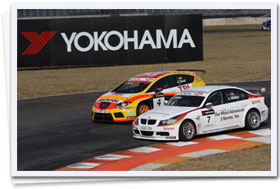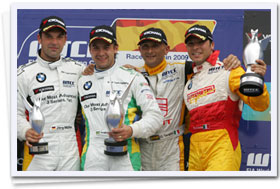This is the sixth season for the FIA World Touring Car Championship (WTCC) since its inception in 2005. It is one of four FIA sanctioned world championships along with F1 (Formula One World Championship), WRC (World Rally Championship) and GT1 (GT1 World Championship which was newly added to them, as the sanctioning body decided to give the world championship title to the GT1 class of FIA-GT for 2010. ) GT1 falls into a category of touring car race, as with WTCC, but the former is an endurance race championship while the latter is run in a sprint race format.
The WTCC's race format remains unchanged since its first season and one event consists of two 30 minute (approximately 50km) races on the final day. The championship points, as well as Independent class points, are to be given to the higher-ranking drivers of each race of the day.
"Easy-to-follow" are the exact words to explain the appeal of WTCC races. Even if you don't know much about the race regulations or profiles of participating drivers, you will still be able to enjoy the best part of motor racing by watching the fierce battles right from the moment of start. As they are true sprint races, there is no position change during pit stops or complicated strategies. The faster drivers simply run ahead of others. Period. So you can just focus what's happening on the track.

The hotly fought races are sometimes described as "a combat sport on the circuit" and there are good reasons why you almost always see such close and thrilling racing. The series has some ingenious measures to give more excitement to the races, including performance equalizing rules between two types of cars eligible for WTCC, the Super 2000 cars with 2000cc petrol engines and the Diesel 2000 cars with 2000cc turbo charged diesel engines.
One such example is the reverse grid system. The starting grids for Race 2 are to be decided by the result of preceding Race 1, but the top eight finishers of Race 1 will be placed on their grids in reversed order. This helps to make the second race of the day so unpredictable from the first corner to the checkered flag.
Ā@
| Reverse Grid System |
| Result of Race 1 |
1st |
2nd |
3rd |
4th |
5th |
6th |
7th |
8th |
|
Āę |
Āę |
Āę |
Āę |
Āę |
Āę |
Āę |
Āę |
| Grid for Race 2 |
8th |
7th |
6th |
5th |
4th |
3rd |
2nd |
1st
(P.P.) |
|
|
Ā@
The weight compensation system, which was introduced in 2009 and proved
to be very effective, is another example. This adds or reduces the handicapping
weight for each car model, not for each driver, according to the average
lap times of the models calculated from a somewhat complicated formula.
Though the formula may not look simple and plain, the system certainly
has no ambiguity. Aiming to equalize the performance difference due to
different transmission systems or different engines, the weight compensations
are adjusted for each event and it worked fairly and impartially last year.
The virtue of this system is that it doesn't kill the character of each
car model too much and still allows the competitors to utilize the strong
points of their cars during a race.
Ā@
| Compensation Weight System |
The designated weight is given to each of FIA's vehicle homologation numbers - all cars belong to the same model will run on the same minimum weight.
(a) The best lap times of the top two qualifiers of each model.
(b) The fastest lap times of each model in two races of an event.
Ā® The average of (a) and (b) = (c).
(d) The three-event rolling average of (c).
ĀúThen, calculate the difference in (d) between a model and the fastest model.
| Depending on the difference, the minimum weight of the slower model will be as follows: |
| within 0.3 sec. |
No compensation |
| more than 0.3 sec. |
-10kg per 0.1 sec.
(up to -60kg) |
If the difference gets
within 0.3 sec. |
by the weight deduction
+10kg per 0.1 sec. |
|
|
Ā@
The championship point system has been changed for 2010. Now the overall
top ten finishers of each race receive the championship point(s), while
the top eight did last year. It is the same system with that of Formula
One and the winner earns 25 points this year, whereas the winning driver
got ten points last year. Otherwise, the 2010 regulations basically remain
the same with that of 2009.
Ā@
| Championship Point System |
| 1st |
2nd |
3rd |
4th |
5th |
6th |
7th |
8th |
9th |
10th |
| 25 |
18 |
15 |
12 |
10 |
8 |
6 |
4 |
2 |
1 |
|
|
Ā@

The qualifying format is also unchanged from last year. All participating drivers try to put their fastest lap times in the first 20 minute session, Part 1, and only top ten qualifiers in this session are allowed to go on in the second 10 minute session, Part 2, which began after a five minute intermission. The first ten grids for Race 1 are to be decided by the qualifying times in the second session and the grids lower than tenth by the times registered in the first.